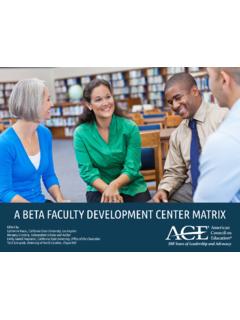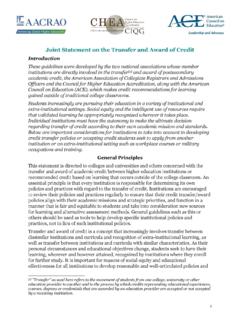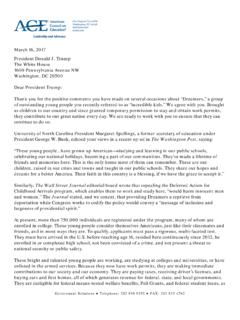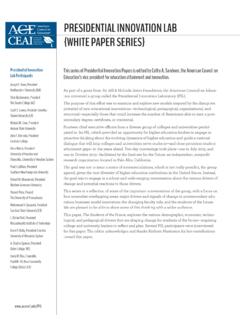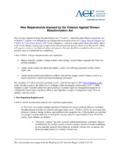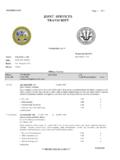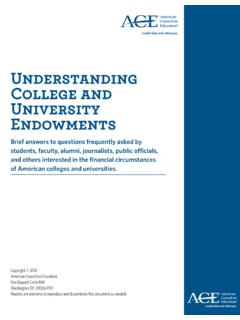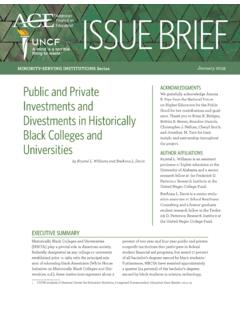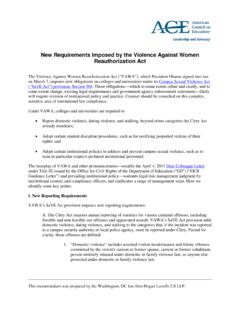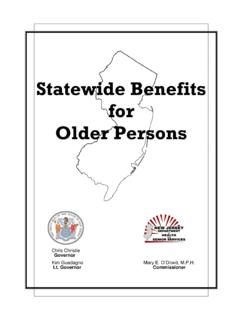Transcription of An Overview Higher Education - acenet.edu
1 An Overview of Higher in the Education United States: Diversity, access , and the Role of the Marketplace By Peter D. Eckel and Jacqueline E. King American Council on Education The Unifying Voice for Higher Education This publication originally appeared as a chapter in J. Forest and P. Altbach (Eds.), The International Handbook of Higher Education (two volumes), published by Springer. Available at No part of this book may be reproduced or transmitted in any form or by any means electronic or mechanical, including photocopying, recording, or by any information storage and retrieval system, without permission in writing from the publisher.. American Council on Education ACE and the American Council on Education are registered marks of the American Council on Education . American Council on Education One Dupont Circle NW. Washington, DC 20036. Table of Contents Introduction .. iii The Distinctive Characteristics of Higher Education .. 1. Size and Composition of Higher Education .
2 1. Governance .. 3. Finance .. 5. Students.. 7. The Curriculum and Degrees .. 9. Faculty and Their Appointments .. 10. University Administration .. 11. Student Life and Athletics .. 12. Current Challenges Confronting Higher Education .. 15. The Marketplace (Not Government) as Key External Driver .. 15. Higher Education as an Engine of Mobility .. 16. Other Current Issues .. 17. Conclusion .. 19. References .. 20. Introduction US .. Higher Education borrows its structure from both the British undergraduate college and German research university, but its character is profoundly influenced by three major philosophical beliefs that shape American public Informed by the Jeffersonian ideals of limited government and freedom of expression, states, religious communities, and individuals established and maintain a range of Higher Education institutions and continue to protect these institutions from the levels of government control seen in most other countries. The second set of influences is capitalism and the belief in the rationality of markets.
3 American colleges and universities vie for students, faculty, and funding under the assumption that diversity and high quality are best achieved through competition rather than centralized planning. The final major philosophical influence on American Higher Education is a widespread commitment to equal opportunity and social mobility. Higher Education was an elite activity for much of its history, excluding individuals based on gender, religion, race/ethnicity, and social class. However, during the 20th century, economic and social changes transformed Higher Education into a primary gateway to the middle-class, and women and minorities made inroads against longstanding exclusion from mainstream Higher Education . Americans came to view broad access to Higher Education as a necessary component of the nation's ideal as a land of opportunity.. Higher Education responded by broadening access . Indeed, the one uniquely American type of institution the community college was founded in the 20th century to ensure open access to Higher Education for individuals of all ages, preparation levels, and incomes.
4 Guided by these beliefs, Higher Education reflects essential elements of the American character: independence, suspicion of government, ambition, inclusiveness, and competitiveness. This publication describes the major characteristics of American Higher Education and important issues that challenge it, linking back as appropriate to these essential philosophical underpinnings. 1. In the United States, several important terms differ in meaning from most of the rest of the world. The term college refers to an institution that typically awards only undergraduate degrees. The term faculty can refer either to an individual professor or to all instructors ( , The Harvard faculty approved a new degree program. ). American Council on Education iii The Distinctive Characteristics of Higher Education B. ecause American Higher educa- federal student aid programs and therefore tion is so diverse and complex, are not counted by the federal government any description of standard ( Department of Education , 2003).
5 Practice inevitably misstates Degree-granting institutions are much about individual colleges typically divided into four major groups, and universities. Indeed, important and a considerable amount of diversity exceptions to most of the characteristics exists within each group: described in this paper exist. Nonetheless, America's 1,100 public two-year insti- this section provides an Overview of how tutions, or community colleges, enroll most colleges and universities are governed the largest share of undergraduates and financed, their students and faculty, (6 million students in 2001). These and the nature of the curriculum and institutions award associate degrees in student life. vocational fields, prepare students for transfer to four-year institutions, and Size and Composition of serve their communities by providing a Higher Education wide array of educational services. In addition to diversity, autonomy, com- These services range from specialized petition, and accessibility, size is a distin- training for large employers, to English guishing feature of Higher Education .
6 Language instruction for recent immi- The Department of Education counts grants, to recreational courses. Almost 6,500 postsecondary institutions that 4 million students attended community participate in its student financial aid colleges part-time in 2001. The programs, including 4,200 colleges and government does not track enrollment universities that award degrees and 2,300 figures for noncredit adult Education or institutions that award vocational certifi- recreational courses, but the American cates. These 6,500 institutions enrolled Association of Community Colleges approximately 16 million full- and part- estimates that an additional 5 million time students, including 14 million under- students enroll in these types of courses graduates and 2 million graduate and at community colleges every year. professional students, in fall 2001. The There are only 630 public four-year 4,200 colleges and universities awarded colleges and universities in the United more than million degrees in academic States.
7 But these institutions which year 2000 01. In addition, an untold include regional comprehensive number of other institutions offer universities that concentrate on under- post-secondary instruction of some type graduate teaching and graduate but do not choose to participate in the preparation in professional fields such American Council on Education 1. as teaching and business, as well as For-profit institutions primarily offer research universities that offer a vocational programs that result in comprehensive set of undergraduate, certificates rather than degrees. Of the graduate, and professional degree more than 2,400 for-profit institutions programs enrolled million counted by the Department of students in 2001. This figure includes Education , 500 offer two-year associate 5 million undergraduates and slightly degrees and 320 offer bachelor's more than 1 million graduate and/or graduate degrees. In total, Private not-for-profit institutions are for-profit institutions enrolled more extremely diverse, including research than 750,000 students in 2001, all universities, four-year liberal arts but 50,000 of whom were at the colleges that focus on undergraduate undergraduate level.
8 Teaching, a small number of two-year institutions, faith-based institutions Table 1 provides an Overview of enroll- that maintain strong links with ment in each of these four sectors. This religious denominations, women's large number and wide range of institu- colleges, historically black colleges tions offer both access and choice two and universities, and specialized hallmarks of American Higher Education institutions that focus on a single field, that respond to the previously described such as nursing or fine arts. Private value placed on opportunity and faith in not-for-profit institutions enrolled the market. million students in 2001, including million undergraduates and more than 700,000 graduate students. Table 1. Postsecondary Institutions and Enrollments: Fall 2001. Public Private Private Total Not-for-Profit For-Profit Institutions 2,099 1,941 2,418 6,458. Four-Year 629 1,567 324 2,520. Two-Year 1,165 269 779 2,213. Less than Two-Year 305 105 1,315 1,725.
9 Enrollment 12,370,079 3,198,354 765,701 16,334,134. Four-Year 6,236,486 3,120,472 321,468 9,678,426. Two-Year 6,047,445 63,207 241,617 6,352,269. Less than Two-Year 86,148 14,675 202,616 303,439. 2. The number of graduate and undergraduate students does not add to the total number of students because some students may take courses outside a formal degree program and, in other cases, the degree level of students was not reported. 2 AN Overview OF Higher Education IN THE UNITED STATES. Governance advocate to the legislature on behalf of Another of the philosophical underpin- public colleges and universities. In some nings of Higher Education is the states, more than one multi-campus Jeffersonian notion of limited and, system exists, such as California's distinct whenever possible, locally controlled systems of community colleges, compre- government. Based on this model, the hensive state colleges and universities, Constitution reserves for the states and research universities.
10 All government functions not specifically Because the Constitution does not described as federal. Among those func- mention Education as a federal responsi- tions is Education . As a result, each of the bility, the federal government plays a lim- 50 states is responsible for governing ited role and the United States has never public colleges and universities (which had an Education ministry, such as those enroll 75 percent of students), rather than found in most other countries. With the the federal government. The degree of important exception of the Morrill Land control by the states varies tremendously. Grant Act of 1862, which donated federal Some institutions, such as the University territory to the states for the establish- of California and the University of ment of public universities, the federal gov- Michigan, enjoy constitutional autonomy ernment played almost no role in Higher as separate branches of state government. Education until the middle of the 20th At the other extreme, locally elected century, when World War II necessitated boards of trustees govern some commu- the establishment of federal funding for nity colleges.
